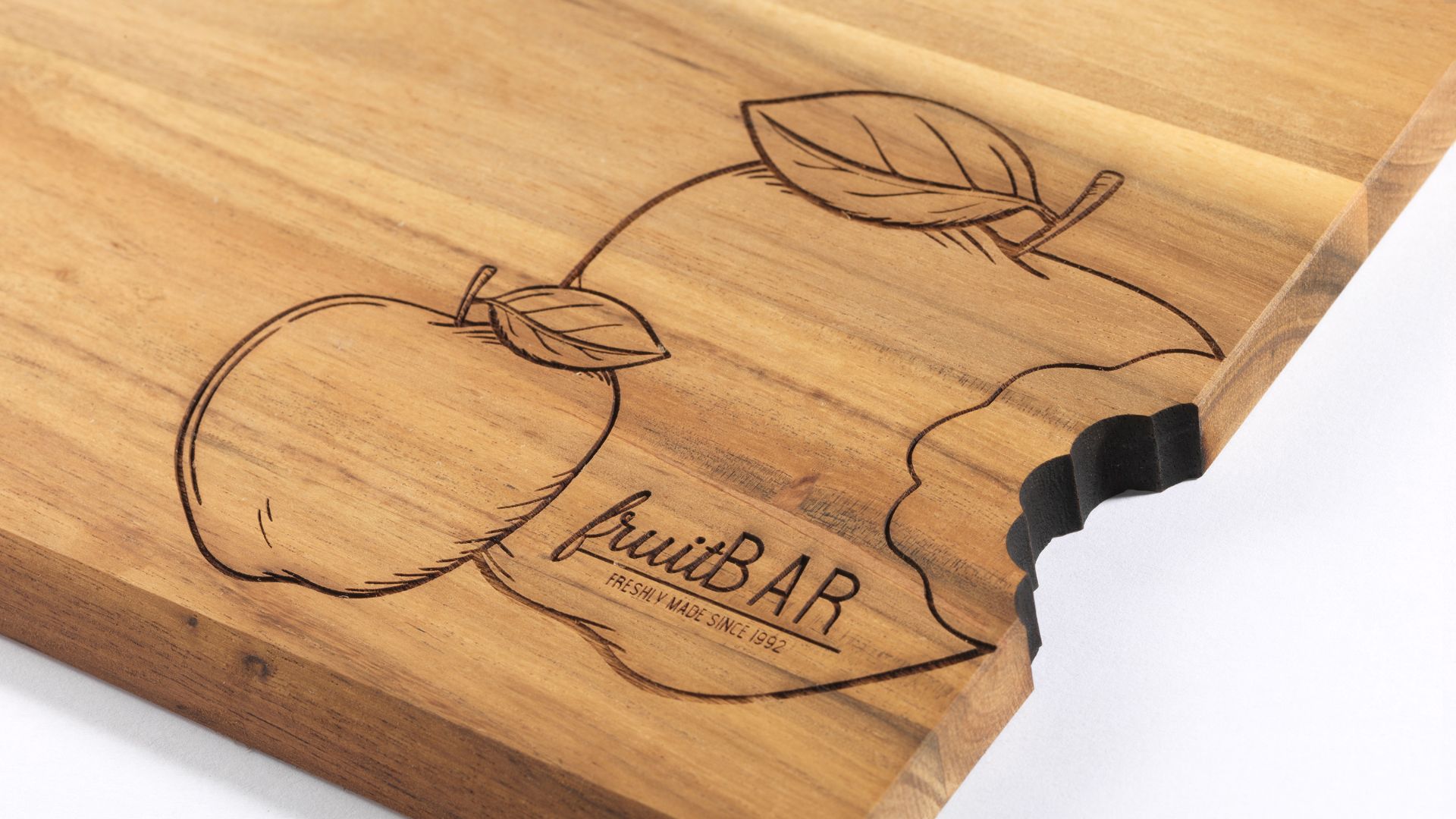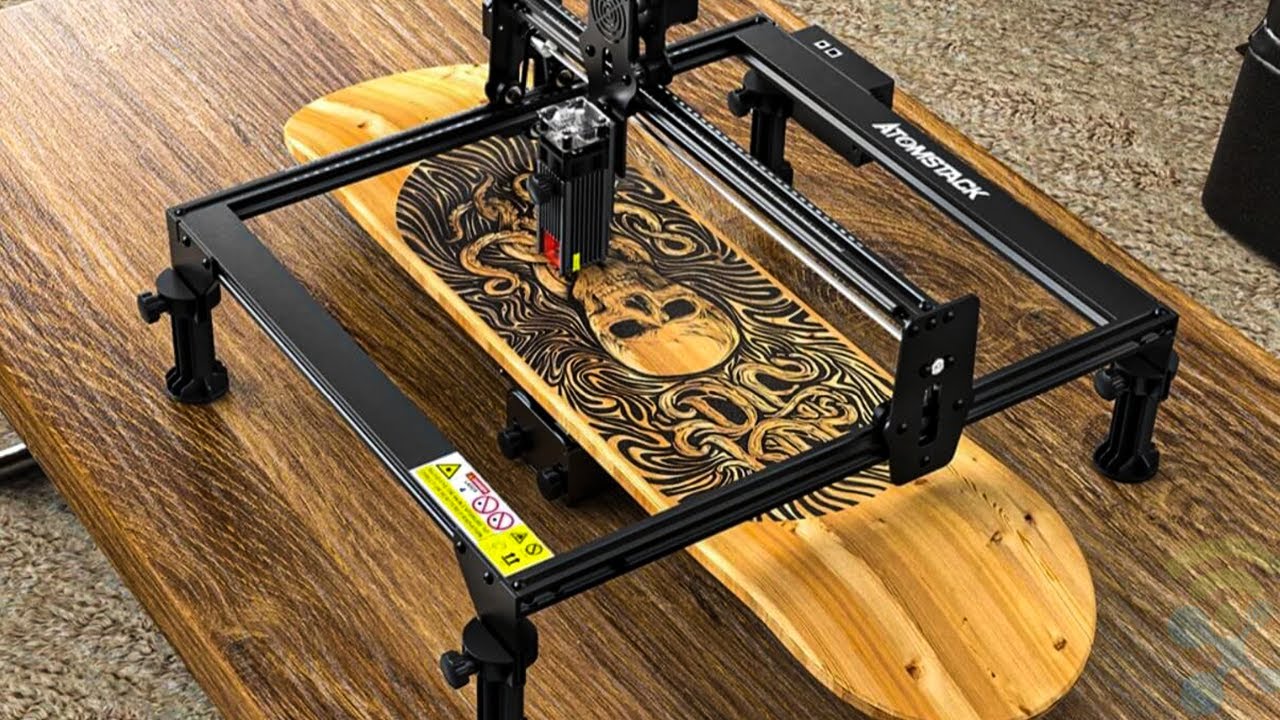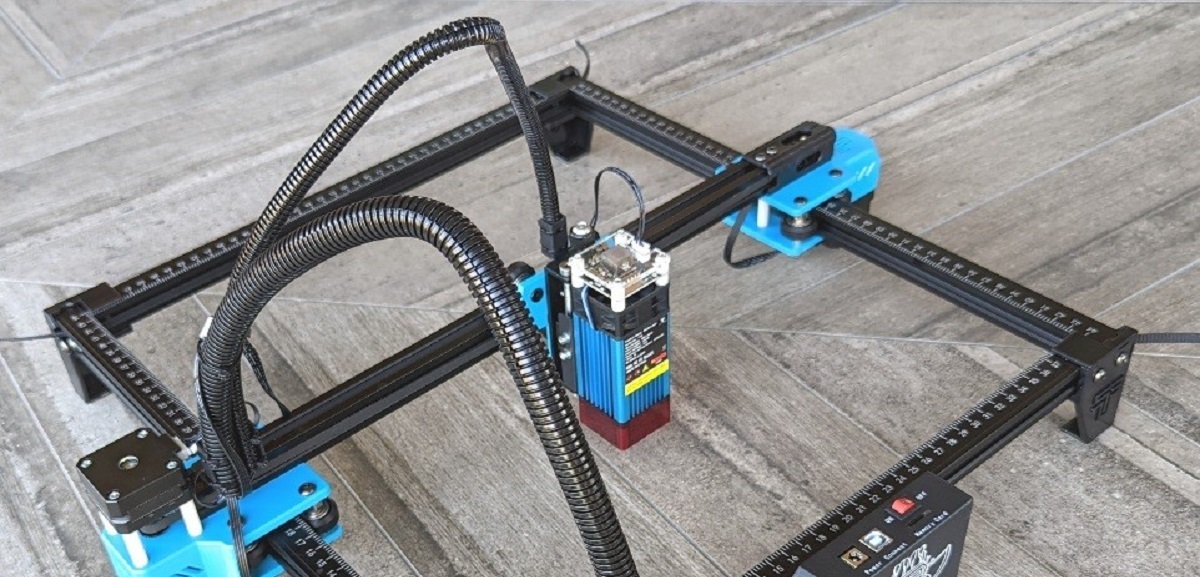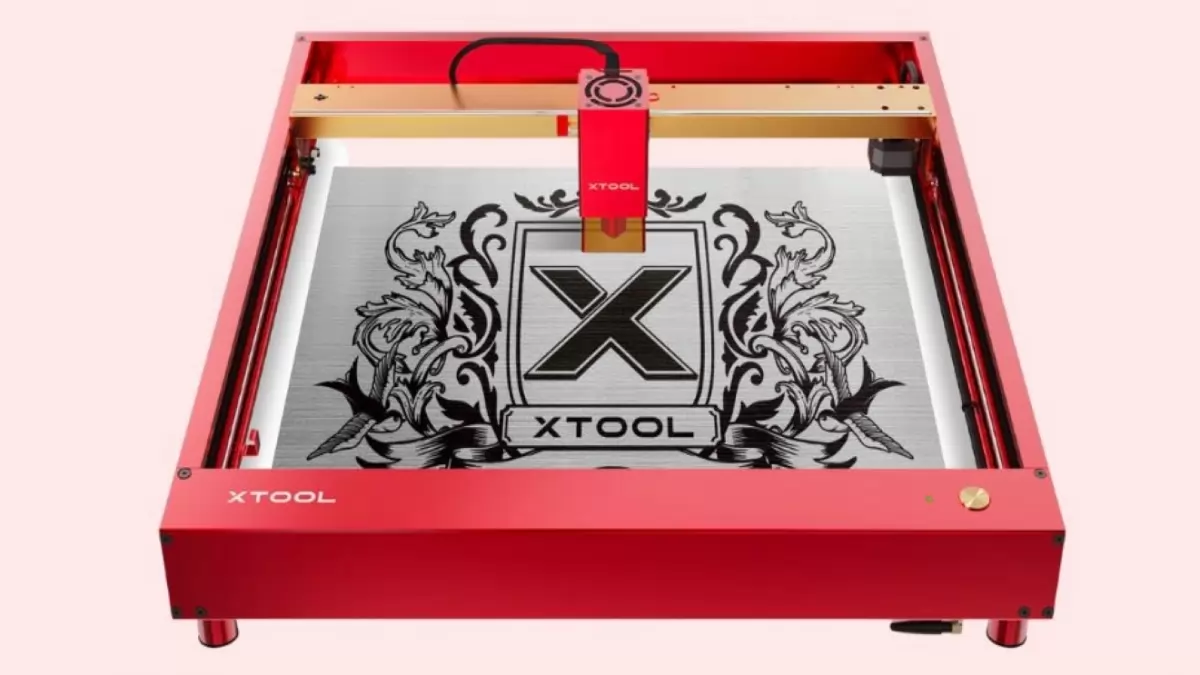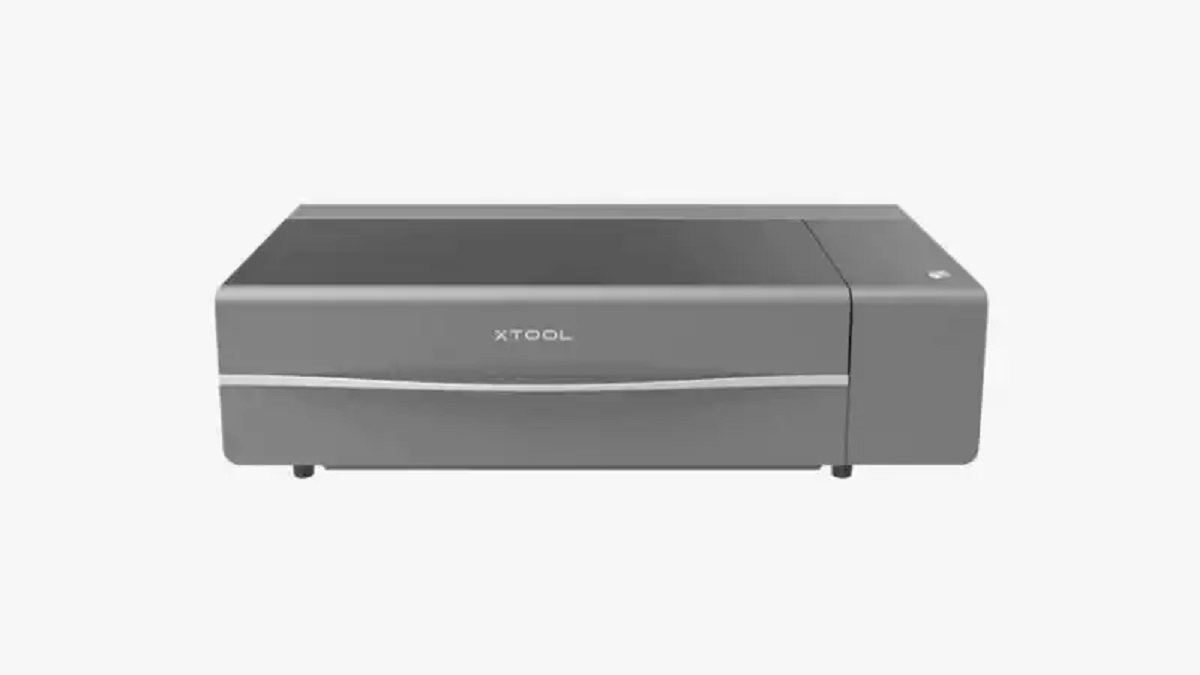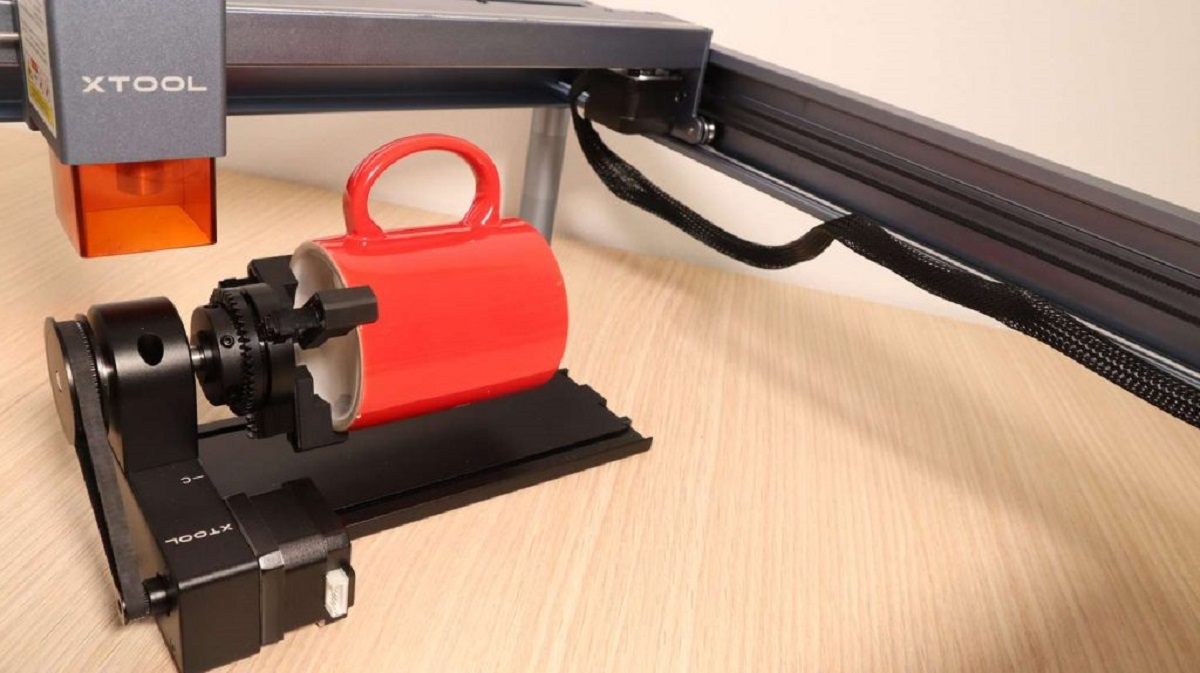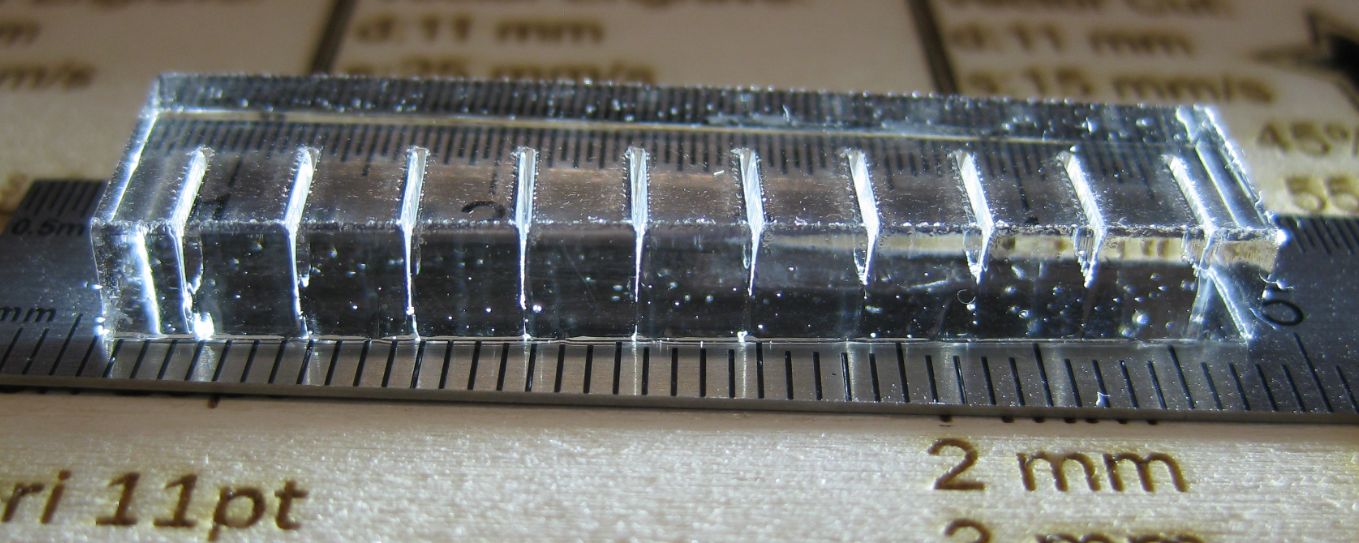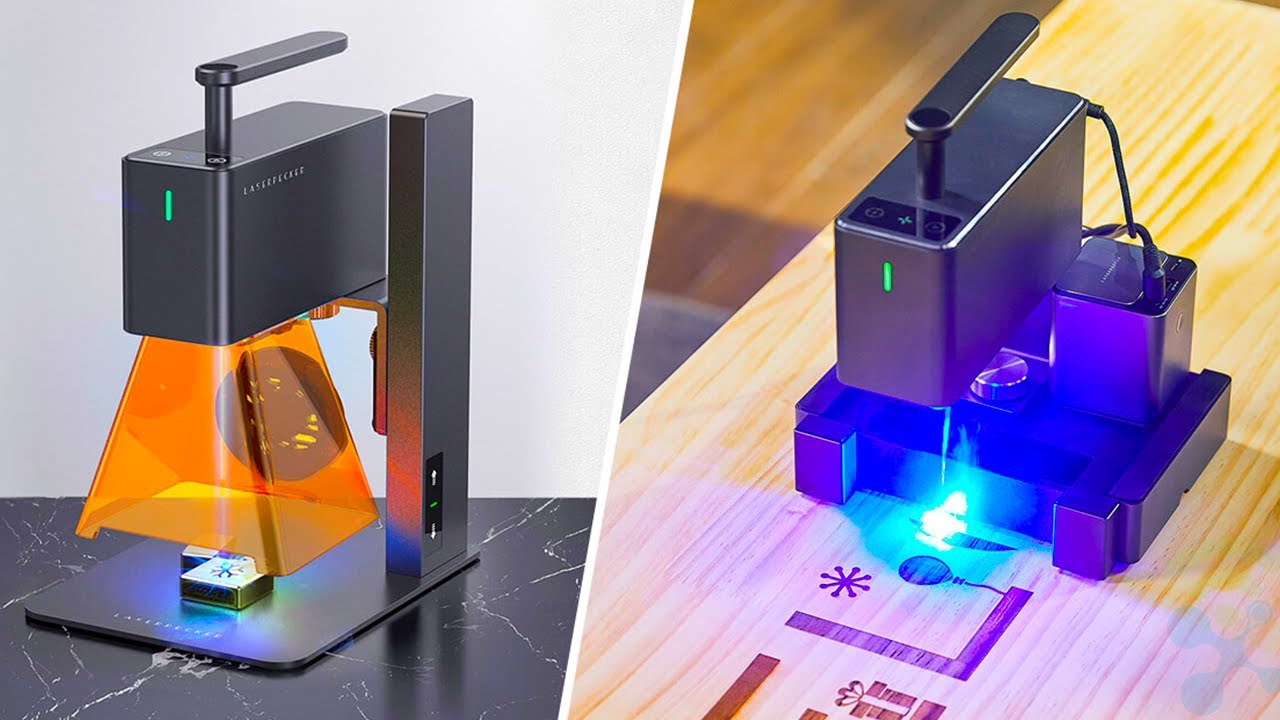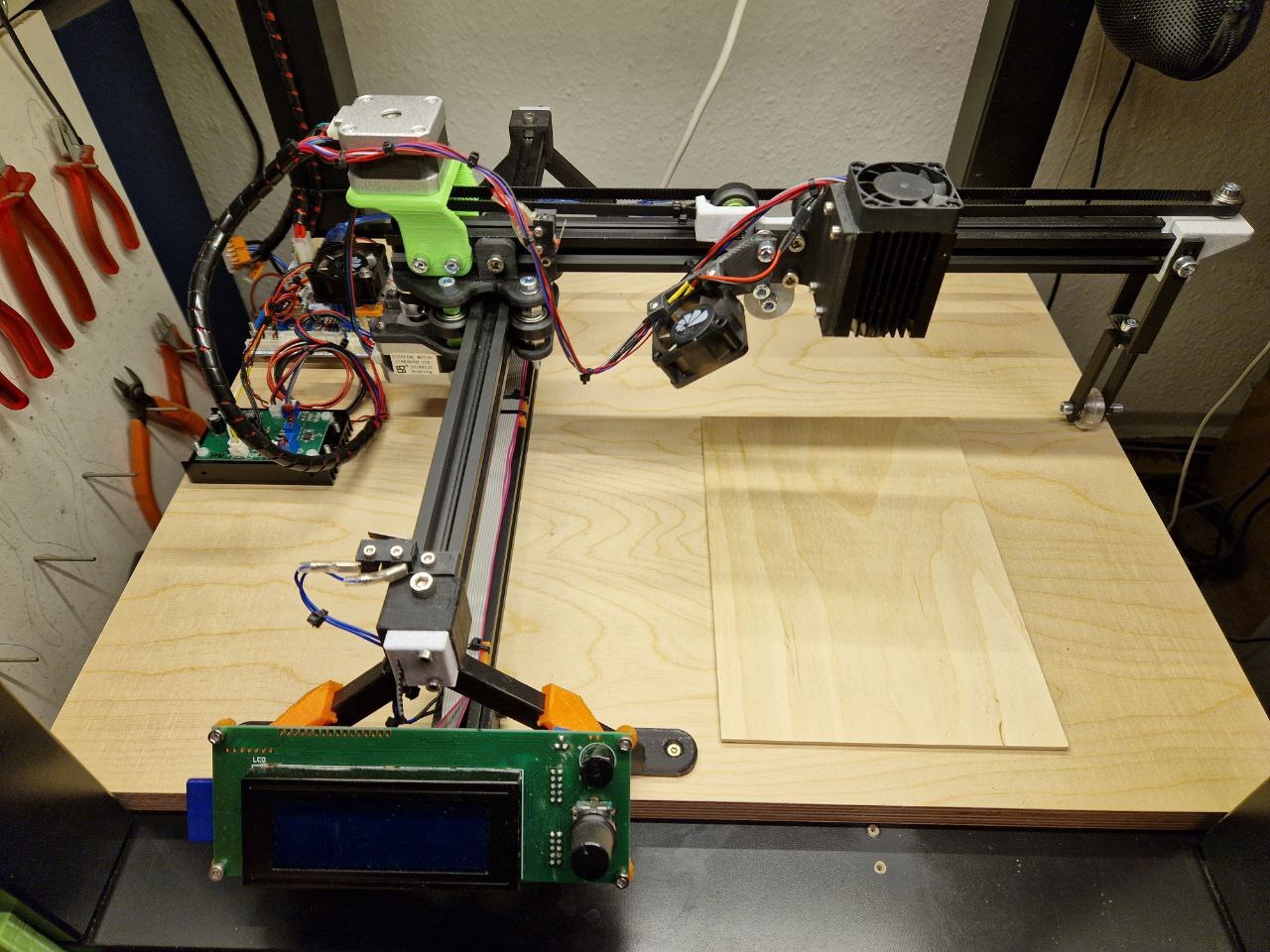Introduction
When it comes to laser engraving, the type of wood you use plays a crucial role in achieving the desired results. Whether you’re a seasoned professional or just starting out, knowing which woods are compatible with a laser engraver is essential.
Laser engraving on wood offers a wide range of possibilities, including personalized gifts, intricate designs, and detailed artwork. However, not all woods are suitable for laser engraving due to differences in density, composition, and moisture content. By understanding the characteristics of different woods, you can choose the right material for your laser engraving project.
In this article, we will explore various categories of wood that can be used with a laser engraver. We will discuss softwoods, hardwoods, exotic woods, as well as some popular wood-based materials like plywood, MDF, and veneer. Each type of wood has its unique features and considerations when it comes to laser engraving. Let’s dive in and discover the world of laser-compatible woods.
Softwoods
Softwoods are one of the most common types of wood used for laser engraving due to their availability and affordability. These woods typically come from coniferous trees and have a lower density compared to hardwoods. Here are some popular softwoods that are compatible with laser engraving:
- Pine: Pine is a softwood that offers a light color and a smooth grain pattern. It engraves well and can be easily stained or painted, making it popular for crafts and decorative items.
- Cedar: Cedar is known for its distinct aroma and rich reddish-brown color. It engraves beautifully, revealing a warm and rustic appearance. Cedar is often used for signs, plaques, and furniture.
- Fir: Fir wood has a pale yellow color and a straight grain. It engraves cleanly and is commonly used for laser-cutting applications like architectural models, artwork, and prototypes.
- Redwood: Redwood has a gorgeous reddish-brown hue and a tight grain pattern. It engraves with fine details and is ideal for creating intricate designs, personalized items, and engraved jewelry.
- Spruce: Spruce is a light-colored wood with a straight grain. It engraves well and is popular for laser-cutting crafts, model making, and architectural prototypes.
Softwoods are generally less expensive and easier to work with compared to hardwoods, making them a popular choice for laser engraving projects. They are suitable for various applications, including signage, home decor, and personalized items. Remember to adjust your laser settings according to the density and moisture content of the specific softwood you are using to achieve the desired engraving results.
Pine
Pine is a popular softwood choice for laser engraving due to its availability, affordability, and ease of engraving. It is widely used for various applications, including crafts, signs, furniture, and decorative items.
One of the advantages of pine is its light color, which provides a blank canvas for laser engravings. The pale yellowish hue of pine showcases engraved designs with clarity and contrast. Whether you’re engraving intricate patterns, text, or simple designs, pine is a versatile option.
Another benefit of using pine for laser engraving is its smooth and consistent grain pattern. This allows for clean and precise engravings, resulting in sharp details and fine lines. The even texture of pine ensures that the laser burns evenly across the surface, creating a uniform appearance.
Pine is also suitable for staining and painting, allowing you to enhance the engraving with different finishes. You can experiment with various wood stains or acrylic paints to add depth and color to your engraving projects on pine. This versatility makes it an excellent choice for personalized gifts and home decor pieces.
However, it’s essential to note that pine is a softwood, which means it can be more prone to denting and scratching compared to hardwoods. Take care when handling and finishing pine engravings to prevent any damage. Additionally, the soft nature of pine might require adjustments to the laser settings to avoid excessive burning or scorching.
In summary, pine is an accessible and versatile softwood option for laser engraving. Its light color, consistent grain pattern, and easy workability make it ideal for a wide range of projects. Whether you’re a hobbyist or a professional, pine can help you bring your laser engraving ideas to life.
Cedar
Cedar is a beautiful and aromatic softwood that is highly sought after for its distinct qualities. It is commonly used in laser engraving due to its rich color, natural durability, and unique fragrance.
One of the standout features of cedar is its reddish-brown hue, which adds warmth and character to laser engravings. The deep color of cedar enhances the visual appeal of engraved designs, giving them a rustic and inviting aesthetic. Whether you’re engraving text, patterns, or images, cedar provides a stunning backdrop.
In addition to its visual appeal, cedar is known for its natural durability and resistance to decay. This makes it a suitable choice for outdoor applications such as signage and plaques. The engraving on cedar can withstand exposure to the elements, making it a long-lasting option for engraved outdoor structures or furniture.
Another notable characteristic of cedar is its distinct aroma. The pleasant scent of cedar adds a sensory dimension to engraved items, creating a unique and memorable experience for recipients. This aromatic quality makes cedar popular for laser-engraved gifts, keepsakes, and decorative pieces.
When working with cedar, it’s important to note that it has a slightly soft texture. While this can make engraving relatively easy, it’s essential to adjust your laser settings to prevent excessive burning or scorching. Test different power and speed settings to find the optimal parameters for engraving on cedar.
Furthermore, cedar is often used for laser cutting projects due to its straight and uniform grain. The consistency of the grain pattern ensures clean and precise cuts without compromising the integrity of the material.
In summary, cedar is a visually stunning and durable softwood that is well-suited for laser engraving. Its rich color, natural resistance to decay, and aromatic qualities make it an excellent choice for a wide range of engraved items. Consider using cedar for personalized gifts, outdoor signage, or decorative pieces to create lasting impressions.
Fir
Fir wood, a popular softwood choice for laser engraving, offers a combination of versatility and durability. It is known for its pale yellow color and straight grain, making it suitable for a wide range of laser engraving projects.
One of the benefits of using fir for laser engraving is its smooth and even texture. The consistent grain pattern allows for precise and clean engravings, resulting in sharp and detailed designs. Whether you’re engraving intricate artwork or simple text, fir provides a solid foundation for your laser engravings.
Another advantage of fir is its versatility in terms of application. It is commonly used for laser-cutting architectural models, prototypes, and crafts due to its dimensional stability and ease of cutting. The straight grain of fir makes it an ideal choice for laser-cutting intricate designs with accuracy.
Fir wood also engraves well with various depths and shades, allowing for creativity and customization. By adjusting the laser settings, you can achieve different levels of engraving depth on fir, creating contrast and dimension in your designs.
In addition to its engraving capabilities, fir wood is known for its durability. It is resistant to warping and shrinking, making it suitable for both indoor and outdoor applications. Engraved fir signs or plaques can withstand exposure to different weather conditions, ensuring longevity.
When working with fir, it’s important to consider its moisture content. Like other woods, fir should be properly dried and acclimated before using it for laser engraving. This helps prevent warping or cracking during and after the engraving process.
In summary, fir wood is a versatile and durable option for laser engraving. Its smooth texture, straight grain, and dimensional stability make it suitable for a wide range of projects, from architectural models to personalized crafts. By utilizing the engraving capabilities of fir, you can create stunning and lasting designs.
Redwood
Redwood, a distinct and beautiful softwood, is highly valued for laser engraving due to its rich reddish-brown color and tight grain pattern. It is an excellent choice for creating intricate designs, personalized items, and engraved jewelry.
One of the standout features of redwood is its stunning natural hue. The deep reddish-brown color adds warmth and elegance to laser engravings, creating visually striking results. The color depth of redwood enhances the contrast and definition of engraved designs, making them truly stand out.
In addition to its visual appeal, redwood boasts a tight and consistent grain pattern. This smooth grain allows for precise and detailed engravings, capturing even the finest lines and delicate artwork. Whether you’re engraving text, images, or patterns, redwood provides an excellent canvas for intricate designs.
Redwood is also known for its durability and resistance to decay. With proper sealing or finishing, engraved redwood pieces can withstand outdoor conditions, making them suitable for signs, plaques, and other outdoor applications. Its natural resistance to rot ensures that engraved redwood items will last for years to come.
When engraving on redwood, it’s important to adjust the laser settings to avoid excessive burning or scorching. Redwood is a relatively soft wood, so finding the right balance between power and speed is crucial to achieve optimal engraving results. Test different settings to ensure a clean and precise engraving outcome.
Furthermore, redwood is a sustainable choice for laser engraving as it is harvested from responsibly managed forests. By choosing redwood for your engraving projects, you not only create stunning pieces but also contribute to environmental conservation.
In summary, redwood is a versatile and visually appealing softwood that is well-suited for laser engraving. Its rich reddish-brown color, tight grain pattern, and durability make it an excellent choice for intricate designs and personalized items. Consider using redwood for engraving jewelry, signs, or decorative pieces to add timeless elegance to your creations.
Spruce
Spruce is a light-colored softwood that is commonly used for laser engraving due to its straight grain and ease of engraving. It offers a versatile and cost-effective option for various laser engraving projects, including crafts, model making, and architectural prototypes.
One of the advantages of using spruce for laser engraving is its light color. The pale hue of spruce provides a blank canvas for engraving, allowing the designs to stand out. Whether you’re engraving text, patterns, or images, spruce offers a clean and consistent background that enhances the visibility of the engraving.
Another benefit of spruce is its straight and uniform grain pattern. This allows for precise and accurate engravings, resulting in sharp details and clean lines. The consistent grain structure of spruce ensures that the laser burns evenly across the surface, creating a uniform appearance.
Additionally, spruce is relatively easy to work with, both in terms of engraving and laser cutting. Its soft texture and straight grain make it a suitable choice for handling intricate designs or delicate pieces. You can achieve intricate and detailed engravings on spruce without compromising the integrity of the wood.
It’s important to note that spruce may have variations in density and moisture content, depending on the specific type and source. Therefore, it is recommended to adjust your laser settings accordingly to avoid excessive burning or scorching. Test different power and speed settings to find the optimal parameters for engraving on spruce.
In summary, spruce is a versatile and affordable softwood option for laser engraving projects. Its light color, straight grain, and ease of engraving make it suitable for a wide range of applications, from crafts and model making to architectural prototypes. By utilizing the engraving capabilities of spruce, you can bring your laser engraving ideas to life with precision and creativity.
Hardwoods
Hardwoods are known for their durability, strength, and distinct grain patterns, making them highly desirable for laser engraving projects. These woods offer a wide range of colors, textures, and characteristics that add a touch of elegance and sophistication to any engraving. Here are some popular hardwoods that are compatible with laser engraving:
- Oak: Oak is a sturdy hardwood with a prominent grain pattern and a range of shades, from light to dark. It engraves beautifully and is commonly used for personalized gifts, furniture, and decorative items.
- Maple: Maple is a light-colored hardwood with a fine and even grain pattern. It engraves with precision and clarity, revealing intricate details. Maple is often used for cutting boards, household items, and engraved artwork.
- Walnut: Walnut is a rich, dark hardwood with a pronounced grain pattern. It engraves beautifully, creating a stunning contrast between the engraved areas and the naturally dark wood. Walnut is a popular choice for awards, plaques, and high-end furniture.
- Cherry: Cherry wood offers a warm, reddish-brown tone and a smooth grain pattern. It engraves elegantly, revealing a deep and rich appearance. Cherry is frequently used for personalized items, artwork, and decorative pieces.
- Mahogany: Mahogany is a luxurious hardwood with a reddish-brown color and a distinctive grain pattern. It engraves with precision, highlighting the natural beauty of the wood. Mahogany is often utilized for high-end furniture, musical instruments, and engraved plaques.
Hardwoods are generally denser and harder compared to softwoods, which can present a challenge when engraving. It is crucial to adjust your laser settings to account for the density and hardness of the specific hardwood you are using. Test different power and speed settings to achieve the desired engraving depth and clarity.
Hardwoods offer a touch of elegance and sophistication to any laser engraving project. The distinct grain patterns and rich colors of hardwoods create a visually captivating result that is sure to impress. Whether you’re engraving personalized gifts, artwork, or high-end furniture, hardwoods provide a durable and beautiful canvas for your laser engravings.
Oak
Oak is a popular hardwood choice for laser engraving due to its durability, beautiful grain patterns, and wide range of color variations. It is a versatile wood that can be used for a variety of laser engraving projects, from personalized gifts to furniture and decorative items.
One of the standout features of oak is its prominent and distinctive grain patterns. The grain patterns can range from straight and simple to more intricate and wavy, adding depth and character to the engraving. This unique visual element enhances the overall appearance of the engraved design.
Another advantage of oak is its range of color variations. Oak can be found in light shades, such as white oak, to darker tones, like red oak. This variety allows for creativity and customization in laser engraving projects, as the engraving can be enhanced by the natural color of the wood.
Oak engraves beautifully, revealing precise and sharp details. Its density allows for clean and crisp engravings, showcasing even the most intricate designs and fine lines. Whether you’re engraving text, images, or patterns, oak provides a solid foundation for achieving high-quality results.
In addition to its aesthetic qualities, oak is known for its durability and longevity. It is a dense hardwood that is resistant to wear and tear, making it suitable for engraved items that need to withstand everyday use. Oak is often used for personalized cutting boards, plaques, and furniture pieces due to its robust nature.
When laser engraving on oak, it is important to adjust the laser settings to account for the density of the wood. Due to its hardness, oak may require higher power and slower speeds for engraving compared to softer woods. Testing different settings and conducting trials can help achieve the desired engraving depth and clarity.
In summary, oak is a versatile and durable hardwood that offers stunning results when laser engraved. Its distinctive grain patterns, color variations, and engraving capabilities make it ideal for a range of projects. By utilizing the unique qualities of oak, you can create personalized and long-lasting laser engraving pieces.
Maple
Maple is a popular hardwood choice for laser engraving due to its light color, fine grain pattern, and versatility. It is highly regarded for its natural beauty and ability to create stunning engraved designs.
One of the standout features of maple is its light-colored appearance, which provides an excellent contrast for laser engravings. The pale tone of maple allows engraved designs to stand out with clarity and visibility. Whether you’re engraving detailed artwork, text, or patterns, maple provides a clean and consistent background.
In addition to its color, maple is known for its fine and even grain pattern. The smooth grain allows for precise and intricate engravings, capturing even the finest lines and delicate details. The tight grain structure of maple ensures that the laser burns evenly across the surface, resulting in a uniform and high-quality engraving.
Another advantage of maple is its versatility. It accepts different types of finishes, including stains and paints, which can further enhance the engraved design. By experimenting with different finishes, you can add depth and color to your maple engravings, creating visually striking and personalized pieces.
Furthermore, maple is a dense and durable hardwood, making it suitable for various laser engraving applications. It is commonly used for cutting boards, household items, and engraved artwork that require longevity and durability. The hardness of maple ensures that the engraved design will withstand everyday use.
When engraving on maple, it’s important to adjust the laser settings to account for its density. Due to its hardness, maple may require higher power and slower speeds for engraving compared to softer woods. Testing different settings and conducting trials can help achieve the desired engraving depth and precision.
In summary, maple is a versatile hardwood that offers a pristine canvas for laser engraving projects. Its light color, fine grain pattern, and durability make it an excellent choice for creating detailed and visually stunning engravings. By utilizing the qualities of maple, you can produce personalized and timeless laser engraving pieces.
Walnut
Walnut, a rich and dark hardwood, is highly sought after for laser engraving projects due to its distinctive grain patterns and elegant appearance. It is a versatile wood that adds a touch of sophistication to any engraving, making it popular for awards, plaques, high-end furniture, and personalized gifts.
One of the standout features of walnut is its natural dark color. The deep brown shades of walnut create a striking contrast when laser engraved, highlighting the engraved designs with depth and clarity. The dark tone of walnut adds a sense of luxury and elegance to any engraving project.
In addition to its color, walnut is known for its pronounced and unique grain patterns. The grain patterns can range from straight and uniform to more irregular and swirling. This beautiful variation adds character and visual interest to laser engravings, making each piece unique and captivating.
Walnut engraves beautifully, allowing for crisp and detailed engravings. Its density and fine grain structure allow for precise and sharp patterns, capturing even the most intricate designs with precision. The laser burns evenly across the surface, resulting in a high-quality and professional-looking engraving.
Furthermore, walnut is a durable and long-lasting hardwood. Its hardness and stability make it suitable for engraved items that need to withstand daily use. Whether it’s a personalized cutting board or an engraved plaque, walnut ensures that the engraved design remains intact even with regular handling and use.
When laser engraving on walnut, it’s important to adjust the laser settings to account for its density. Due to its hardness, walnut may require higher power and slower speeds for engraving compared to softer woods. Experimentation with different settings can help achieve the desired engraving depth and clarity.
In summary, walnut is a luxurious hardwood that offers stunning results when laser engraved. Its dark color, distinct grain patterns, and engraving capabilities make it an ideal choice for creating elegant and sophisticated pieces. By harnessing the beauty of walnut, you can produce engraved designs that exude timeless charm and craftsmanship.
Cherry
Cherry wood is a beautiful and versatile hardwood that is highly regarded for its warm reddish-brown color and smooth grain pattern. It is a popular choice for laser engraving due to its natural elegance and ability to create visually appealing designs.
One of the outstanding features of cherry wood is its rich and inviting color. The deep reddish-brown hue adds warmth and character to laser engravings, creating a distinctive and luxurious appearance. The color of cherry wood deepens over time, making engraved designs even more captivating with age.
In addition to its color, cherry wood is known for its smooth and consistent grain pattern. The straight grain allows for clean and precise engravings, showcasing even the finest details with clarity. The tight grain structure of cherry wood ensures that the laser burns evenly, resulting in a polished and refined engraving.
Cherry wood has a natural luster and satin-like sheen, which further enhances the engraved designs. When the laser strikes the surface of cherry wood, it creates a subtle contrast between the engraving and the surrounding wood, adding depth and visual interest to the piece.
Furthermore, cherry wood is a relatively easy wood to work with when it comes to laser engraving. Its medium density and moderate hardness allow for a range of detailing, from intricate artwork to intricate text. It engraves cleanly and precisely, providing a satisfying final result.
It’s worth noting that cherry wood tends to darken over time when exposed to light. UV protective finishes can be applied to limit this color change and maintain the original vibrancy of the engraving.
In summary, cherry wood is a versatile and elegant hardwood for laser engraving projects. Its warm color, smooth grain pattern, and natural luster make it an excellent choice for creating visually appealing and refined designs. By utilizing the qualities of cherry wood, you can produce engraved pieces that exude timeless beauty and sophistication.
Mahogany
Mahogany is a luxurious and highly prized hardwood known for its rich reddish-brown color, distinct grain patterns, and exceptional durability. It is a popular choice for laser engraving projects that require a touch of elegance and sophistication.
One of the standout features of mahogany is its deep and warm reddish-brown color. This natural hue adds a sense of richness and opulence to laser engravings, making them truly stand out. The color of mahogany deepens over time, enhancing the engraved design with a timeless allure.
In addition to its color, mahogany boasts a distinctive and pronounced grain pattern. The grain patterns can range from straight and uniform to more irregular and interlocking, creating a visually captivating texture. The unique grain patterns add depth and character to any laser engraving, making each piece truly unique.
Mahogany engraves with precision and clarity, allowing for sharp and detailed engravings. Its dense and fine grain structure provides a stable surface for intricate designs, capturing even the most delicate lines and intricate details. The laser burns smoothly across the surface, resulting in a professional-looking and polished engraving.
Furthermore, mahogany is renowned for its durability and longevity. It is a hardwood known for its resistance to warping, shrinkage, and decay. Engravings on mahogany remain intact and beautiful for years to come, making it a reliable choice for personalized gifts, plaques, and high-end furniture.
When laser engraving on mahogany, it’s important to adjust the laser settings to account for its density. Mahogany is a relatively hard wood, so higher power and slower speeds may be required for optimal engraving results. Testing different settings and conducting trials can help achieve the desired engraving depth and precision.
In summary, mahogany is a luxurious hardwood that offers outstanding results when laser engraved. Its rich color, distinct grain patterns, and engraving capabilities make it an ideal choice for creating elegant and sophisticated pieces. By harnessing the beauty of mahogany, you can produce engraved designs that exude timeless charm and craftsmanship.
Exotic Woods
Exotic woods are highly sought after for their unique and rare qualities, making them a captivating choice for laser engraving projects. These woods offer a wide range of colors, textures, and grain patterns that add a touch of luxury and distinctiveness to any engraving. Here are some popular exotic woods that are compatible with laser engraving:
- Ebony: Ebony is a dense and dark wood known for its striking jet-black color and smooth texture. It engraves beautifully, creating a stark contrast between the engraved design and the deep black background.
- Rosewood: Rosewood is a stunning hardwood that showcases a range of beautiful colors, from reddish-brown to purplish hues. It engraves with depth and clarity, highlighting the intricate patterns and details in the design.
- Teak: Teak is renowned for its durable and weather-resistant properties, making it suitable for outdoor applications. It engraves elegantly, emphasizing the golden-brown color and intricate grain patterns.
- Bubinga: Bubinga is a captivating hardwood with a reddish-brown color and a striking grain pattern. It engraves with precision, revealing the intricate details and creating a visually stunning result.
- Zebrawood: Zebrawood is recognized for its distinctive striped appearance, resembling the stripes of a zebra. It engraves beautifully, showcasing the contrast between the light and dark tones, creating an eye-catching engraving.
Exotic woods offer an opportunity to create truly unique and one-of-a-kind laser engravings. The rare combination of colors, grain patterns, and textures make each engraving piece a work of art. Whether you’re engraving fine furniture, musical instruments, or decorative items, exotic woods provide a touch of luxury and exclusivity.
When working with exotic woods, it is essential to adjust the laser settings to accommodate their specific characteristics. Due to their density and hardness, some exotic woods may require higher power and slower speeds for optimal engraving results. Testing and experimentation with different settings are recommended to achieve the desired engraving depth and precision.
In summary, exotic woods offer a world of possibilities for laser engraving projects. Their unique colors, grain patterns, and textures create visually captivating designs. By utilizing the distinct qualities of exotic woods, you can produce engraved pieces that exude luxury, rarity, and individuality.
Ebony
Ebony is a highly sought-after exotic wood for laser engraving projects due to its striking jet-black color, dense texture, and smooth surface. It is known for its elegance and timeless beauty, making it a popular choice for creating visually stunning engraved designs.
One of the standout features of ebony is its deep black color. This intense and lustrous hue creates a stark contrast when laser engraved, making the designs truly stand out. The black background allows for precise and detailed engravings, enhancing the visibility and impact of the engraved design.
In addition to its color, ebony boasts a fine and even texture. The smooth surface of ebony is ideal for achieving precise and sharp engravings, capturing intricate details with clarity. The tight grain structure of ebony ensures that the laser burns evenly across the surface, resulting in a polished and refined engraving.
Ebony is a dense and heavy wood, which adds to its durability and longevity. The hardness of ebony allows for clean and defined engravings that will withstand the test of time. Its resistance to wear and tear makes it ideal for engraved items that will be frequently handled or displayed.
When laser engraving on ebony, it is crucial to adjust the laser settings to accommodate its density and hardness. Due to these characteristics, higher power and slower speeds may be required for optimal engraving results. Experimenting with different settings and conducting test runs is recommended to achieve the desired engraving depth and precision.
It’s important to note that ebony is a rare and precious wood, often sourced from sustainable and responsibly managed forests. Its scarcity adds to its allure and value, making engraved pieces on ebony truly special and exclusive.
In summary, ebony is a stunning exotic wood with a rich black color and smooth texture, making it perfect for laser engraving. Its visual impact, durability, and timeless beauty make engraved designs on ebony stand out. By harnessing the unique qualities of ebony, you can create engraved pieces that exude luxury, sophistication, and elegance.
Rosewood
Rosewood is a remarkable exotic wood that is highly valued for its stunning array of colors, captivating grain patterns, and exceptional engraving potential. It is a popular choice for laser engraving projects, as it adds a touch of elegance and sophistication to any design.
One of the standout features of rosewood is its beautiful range of colors. From reddish-brown to purplish hues, rosewood showcases a natural palette that adds depth and richness to laser engravings. The variation in color creates a visually striking contrast, making the engraved designs truly stand out.
In addition to its color, rosewood boasts a mesmerizing grain pattern. The grain patterns can range from straight and uniform to more irregular and interlocking, creating a visual texture that is both unique and captivating. Engravings on rosewood showcase the intricate grain patterns, adding depth and character to the overall design.
Rosewood engraves with precision and depth, allowing for sharp and detailed engravings. Its moderate density and fine grain structure provide a stable surface for intricate designs, capturing even the most delicate lines and intricate details with clarity and precision.
Furthermore, rosewood has a natural luster and smooth surface, which adds to its appeal and engraving potential. The laser seamlessly interacts with the wood surface, creating a beautifully crisp and polished engraving. The ability of rosewood to showcase fine details and produce a smooth finish contributes to the overall high-quality appearance of the engraving.
When laser engraving on rosewood, it is important to adjust the laser settings to accommodate its density and hardness. Rosewood is a dense wood that may require higher power and slower speeds for optimal engraving results. Experimenting with different settings and conducting test runs can help achieve the desired engraving depth and precision.
It is worth noting that rosewood is a prized and rare wood that requires responsible sourcing to ensure its sustainability. Many varieties of rosewood are protected and regulated due to their scarcity, making engravings on rosewood even more exclusive and valuable.
In summary, rosewood is an exquisite exotic wood that offers a range of colors and captivating grain patterns. Its engraving potential, natural luster, and smooth surface make it an ideal choice for producing laser engravings with depth, detail, and refinement. By harnessing the beauty of rosewood, you can create engraved pieces that exude timeless elegance and sophistication.
Teak
Teak, a highly regarded exotic wood, is prized for its remarkable durability, beautiful golden-brown color, and unique grain patterns. It is a popular choice for laser engraving due to its exceptional strength, resistance to weathering, and aesthetic appeal.
One of the standout features of teak is its rich golden-brown color, which offers a warm and inviting hue that deepens over time. The color of teak adds a touch of luxury and elegance to any laser engraving, creating a visually stunning result. The natural beauty of teak is enhanced through laser engraving, further showcasing its distinctiveness.
In addition to its color, teak boasts remarkable grain patterns that add to its allure. From straight lines to swirling patterns, teak’s grain can exhibit a range of stunning variations. The unique grain patterns give depth and character to the engraved designs, creating a captivating visual effect.
Teak is renowned for its exceptional durability and resistance to weathering. It contains natural oils that protect it from rot, decay, and harsh environmental conditions. These properties make teak suitable for both indoor and outdoor applications, making it an excellent choice for engraved signs, furniture, and outdoor decorations.
When laser engraving on teak, it is essential to adjust the laser settings to accommodate its density. Being a hard and dense wood, teak may require higher power and slower speeds for optimal engraving results. Testing and experimenting with different settings can help achieve the desired depth and precision in the engravings.
Moreover, teak is regarded as an eco-friendly choice as it is often sourced from responsibly managed plantations. Teak trees are known for their fast growth, making them a sustainable and renewable resource. By choosing teak for laser engraving projects, you can contribute to the preservation of the environment.
In summary, teak is a durable and aesthetically pleasing exotic wood that offers a stunning golden-brown color and unique grain patterns. Its resistance to weathering and longevity make it suitable for both indoor and outdoor laser engraving applications. By utilizing the beauty and durability of teak, you can create engraved pieces that exude elegance, sophistication, and sustainability.
Bubinga
Bubinga is an exquisite and eye-catching exotic wood, prized for its rich reddish-brown color and distinctive grain patterns. It is a popular choice for laser engraving due to its captivating appearance and its ability to create visually stunning designs.
One of the outstanding features of bubinga is its striking reddish-brown color. The deep and warm hues of bubinga provide a luxurious backdrop for laser engravings. Whether it is text, artwork, or intricate patterns, engraving on bubinga showcases the design with clarity and depth, creating an aesthetically pleasing result.
In addition to its color, bubinga boasts a remarkable grain pattern that adds to its allure. The grain patterns of bubinga can range from straight and uniform to more irregular and interlocking, creating a visually captivating texture. Engravings on bubinga highlight these unique grain patterns, adding depth and character to the overall design.
Bubinga engraves with precision, allowing for sharp and detailed engravings. Its medium to high density and fine grain structure provide a stable surface for intricate designs, capturing even the most delicate lines and intricate details with clarity and precision.
Besides its visual appeal, bubinga is also known for its durability and strength. It is a highly resistant wood, making it suitable for engraved items that need to withstand regular use and handling. Its inherent strength ensures that the engraved design remains intact for a long time.
When laser engraving on bubinga, it is important to adjust the laser settings to accommodate its density. Due to its hardness, higher power and slower speeds may be required for optimal engraving results. Testing different settings and conducting trial runs can help achieve the desired engraving depth and precision.
In summary, bubinga is an exquisite exotic wood known for its rich color and distinctive grain patterns. Its engraving potential, durability, and visual appeal make it an excellent choice for laser engraving projects. By harnessing the qualities of bubinga, you can create engraved pieces that exude luxury, sophistication, and unique character.
Zebrawood
Zebrawood is a stunning and distinctive exotic wood known for its unique striped appearance, resembling the stripes of a zebra. It is highly sought after for its visual appeal and is a popular choice for laser engraving projects that require a bold and eye-catching design.
One of the outstanding features of zebrawood is its striking contrast between light and dark tones. The light golden-brown color combined with dark brown or black stripes creates a visually captivating pattern. When laser engraved, these striped patterns add depth and dimension to the design, making it truly stand out.
In addition to its color, zebrawood has a naturally coarse texture, which adds an interesting visual and tactile element to the engraved pieces. The unique grain patterns and texture of zebrawood give depth and character to the overall design, creating a visually stunning result.
Zebrawood engraves beautifully, allowing for the sharp and precise portrayal of intricate designs. Its medium density and fine grain structure provide a stable surface for detailed engravings, capturing even the most delicate lines and fine details with clarity and precision.
Furthermore, zebrawood is a durable and resilient wood, making it suitable for engraved items that need to withstand everyday use. Its inherent strength ensures that the engraved design remains intact, allowing for long-lasting beauty and enjoyment.
When laser engraving on zebrawood, it is important to adjust the laser settings to accommodate its density. Due to its hardness, higher power and slower speeds may be required for optimal engraving results. Testing different settings and conducting trial runs can help achieve the desired depth and precision in the engravings.
In summary, zebrawood is a visually appealing exotic wood with its striking stripes and unique grain patterns. Its engraving potential, distinctive appearance, and durability make it an excellent choice for laser engraving projects. By harnessing the beauty and uniqueness of zebrawood, you can create engraved pieces that stand out and make a lasting impression.
Plywood
Plywood is a widely used engineered wood product that is popular for laser engraving projects due to its versatility and affordability. It is made by layering thin sheets of wood veneer and bonding them together with adhesive, resulting in a strong and stable material.
One of the advantages of plywood for laser engraving is its smooth and consistent surface. The flat and uniform nature of plywood provides an ideal canvas for engraving designs. This allows for precise and detailed engravings, capturing intricate patterns, text, and artwork with clarity.
Another benefit of plywood is its wide availability and affordability. Plywood comes in various thicknesses and grades, making it suitable for a range of laser engraving applications. Whether you’re creating signage, decorative items, or prototypes, plywood offers a cost-effective solution without compromising on quality.
Plywood also provides flexibility in terms of finishing options. It can be left with its natural appearance or easily stained, painted, or varnished to enhance the engraved designs. This versatility allows for customization and creativity in laser engraving projects on plywood.
When laser engraving on plywood, it’s important to select a variety with a veneer that is suitable for engraving. Choose plywood with a smooth and consistent veneer to ensure optimal engraving results. Additionally, adjusting the laser settings may be necessary to accommodate the thickness and density of the plywood.
It’s worth noting that the number of veneer layers in plywood can vary, resulting in different levels of engraving depth. Thicker plywood with more layers may require multiple passes to achieve the desired depth, while thinner plywood may provide more shallow engravings.
In summary, plywood is a versatile and affordable option for laser engraving. Its smooth surface, availability, and flexibility in finishing options make it a popular choice for a variety of engraving applications. By utilizing the qualities of plywood, you can create engraved pieces that are both visually appealing and budget-friendly.
MDF (Medium-Density Fiberboard)
MDF, or Medium-Density Fiberboard, is a popular material for laser engraving projects due to its smooth surface, consistent density, and affordability. It is made by compressing small wood fibers and adhesive under high pressure, resulting in a dense and uniform board.
One of the benefits of MDF for laser engraving is its smooth and flat surface. The consistent density of MDF allows for precise engraving, capturing fine details with clarity. Its smooth texture provides an excellent canvas for engraving designs, whether it’s intricate patterns or bold lettering.
MDF is widely available and cost-effective, making it a practical choice for a range of laser engraving applications. It is often used for signage, plaques, crafts, and decorative items. Its affordability allows for experimenting with different design ideas and prototypes without breaking the bank.
Another advantage of MDF is its versatility in finishing options. It readily accepts paints, stains, and varnishes, allowing for customization and creativity in laser engraving projects. Adding a finishing touch can enhance the appearance of the engraving and create a unique and personalized result.
When laser engraving on MDF, it’s important to adjust the laser settings to achieve optimal results. MDF is a dense material, so higher power and slower speeds may be required to ensure proper engraving depth without scorching the surface. Testing different settings and conducting trial runs are recommended to achieve the desired effects.
However, it’s worth noting that MDF can produce more noticeable burnt edges compared to other materials. To minimize this, applying a sealant or using masking tape before engraving can help protect the MDF surface and reduce charring.
It’s important to consider that MDF contains adhesives and resins, which can emit fumes when laser engraved. Proper ventilation is necessary to ensure a safe working environment. Additionally, using a high-quality MDF with low formaldehyde emissions is recommended for health and safety purposes.
In summary, MDF is a versatile and cost-effective material for laser engraving. Its smooth surface, consistent density, and affordability make it suitable for a wide range of applications. By utilizing the qualities of MDF, you can create engraved pieces that are both budget-friendly and visually appealing.
Veneer
Veneer is a thin layer of wood that is commonly used for laser engraving projects. It is created by slicing or peeling a log into thin sheets, which are then bonded onto a base material, such as plywood or MDF. Veneer offers a range of wood species, patterns, and color variations, making it a popular choice for achieving a natural wood look in laser engravings.
One of the advantages of using veneer for laser engraving is the wide selection of wood species available. From oak and maple to walnut and cherry, veneer allows you to achieve the natural beauty and characteristics of different woods in your engraving designs. This variety provides flexibility and customization options for various projects.
Veneer is exceptionally thin, typically measuring only a few millimeters thick. This thinness makes it ideal for achieving intricate and detailed engravings. The laser engraves the surface of the veneer with precision, capturing fine lines and delicate artwork accurately.
Furthermore, veneer offers the opportunity to create unique and visually interesting patterns. With techniques such as bookmatching and marquetry, you can arrange veneer pieces to create eye-catching designs and focal points in your laser engravings.
Veneer is compatible with a variety of base materials, such as plywood or MDF. This allows for flexibility in terms of thickness, stability, and cost. Veneered materials are readily available and offer an affordable alternative to solid wood, while maintaining the appearance and effect of natural wood engravings.
When laser engraving on veneer, it is crucial to adjust the laser settings to the specific characteristics of the veneer and the base material. Different veneers may have varying densities and thicknesses, which can affect engraving depth and speed. Conducting tests on scraps of the same veneer is an effective way to determine the ideal laser settings for optimal results.
It’s worth noting that veneer is relatively thin compared to solid wood. Care must be taken during handling to avoid bending or cracking the veneer. Proper adhesive techniques are also crucial when applying veneer to the base material to ensure a strong and long-lasting bond.
In summary, veneer provides the opportunity to achieve the natural beauty of different wood species in laser engraving projects. Its thinness, versatility, and wide range of wood options make it an ideal choice for creating unique and visually appealing engravings. By utilizing the qualities of veneer, you can achieve the natural wood look while maintaining flexibility and cost-effectiveness.
Conclusion
Laser engraving provides a versatile and precise method for creating intricate designs, personalized items, and decorative pieces on various types of wood. Understanding the characteristics and compatibility of different woods is crucial in achieving the desired results.
Softwoods like pine, cedar, fir, redwood, and spruce are commonly used for laser engraving due to their availability, affordability, and ease of engraving. These woods offer a range of colors, grain patterns, and engraving capabilities, making them suitable for a variety of applications.
Hardwoods such as oak, maple, walnut, cherry, and mahogany are known for their durability, unique grain patterns, and elegance. They are ideal for creating high-quality engravings with sharp details and a refined appearance.
Exotic woods like ebony, rosewood, teak, bubinga, and zebrawood provide an opportunity to create truly unique and visually striking engraving designs. These woods showcase exceptional colors, grain patterns, and textures that add luxury and exclusivity to laser engravings.
Additionally, materials like plywood, MDF, and veneer offer affordable options for laser engraving projects. Plywood provides a smooth surface and versatility, while MDF offers consistency and affordability. Veneer allows for achieving the natural beauty of different wood species in an engraving design.
When laser engraving on wood, it is crucial to adjust the laser settings to accommodate the density, hardness, and thickness of the specific wood or material being used. Conducting tests and experimenting with different settings can help achieve optimal engraving depth, precision, and clarity.
Overall, the selection of wood for laser engraving depends on the desired aesthetics, project requirements, and budget considerations. Whether you choose softwoods, hardwoods, exotic woods, or wood-based materials, accurately understanding their characteristics will help you create stunning laser engravings that are durable and visually appealing.







